Experimental Study on Mechanical Properties of High-Ductility Concrete against Combined Sulfate Attack and Dry–Wet Cycles
Abstract
:1. Introduction
2. Experimental Program
2.1. Materials
2.2. Mix Proportion and Specimen Preparation
2.3. Experimental Equipment and Procedure
2.3.1. Experimental Equipment
2.3.2. Experimental Procedure
3. Results and Discussion
3.1. Uniaxial Compressive Strength of HDC
3.2. Loss Rate of Compressive Strength of HDC
4. Damage Mechanism of HDC
4.1. Experimental Phenomena
4.2. Physical and Chemical Damage Mechanism
4.3. Destruction Mechanism of HDC under Uniaxial Compression
4.4. Damage Variables of HDC
5. Conclusions
- (1)
- HDC has toughening and crack resistance, reduces the occurrence of cracks, and increases compactness. According tothe compressive strength test, the failure mode of HDC is drum-shaped with cracks was but not loose—similar to ductile failure—which effectively overcomes the brittle failure characteristics of OC.
- (2)
- With the increase in the number of dry–wet cycles, the compressive strength of HDC generally increases first and then decreases. Before 30 dry–wet cycles, the compressive strength of HDC gradually increased. After 105 dry–wet cycles, the compressive strength of HDC decreasedin a straight line, and the loss rate of the compressive strength of HDC generally increased. Under the same concentration of sulfate solution and the number of dry–wet cycles, the loss rate of the compressive strength of HDC is less than OC. As indicated above, the ability of HDC to resist dry–wet cycles is better than that of OC.
- (3)
- As the concentration of the sulfate solution increases, the max compressive strength of HDC gradually decreases; that is, the damage is intensified. The 5% sulfate solution resulted inno evident damage to HDC, and 10% and saturated solutions resulted inserious damage to the HDC. HDC damage is the result of the combined action of sulfate attack and dry–wet cycles. Comparison shows that HDC has the ability to resist sulfate attack and dry–wet cycles and is superior to OC.
Author Contributions
Funding
Institutional Review Board Statement
Informed Consent Statement
Data Availability Statement
Acknowledgments
Conflicts of Interest
References
- Li, V.C. On engineeredcementitiouscomposites (ECC):Areviewofthematerialanditsapplications. J. Adv. Concr. Technol. 2003, 1, 215–230. [Google Scholar] [CrossRef] [Green Version]
- Liu, H.; Zhang, Q.; Li, V.; Su, H.; Gu, C. Durability study on engineered cementitious composites (ECC) under sulfate and chloride environment. Constr. Build. Mater. 2017, 133, 171–181. [Google Scholar] [CrossRef]
- Bailiche, Z.; Aoualicherif, L.; Cousin, R. The effect of the use of lanthanum-doped mesoporous ceria on the performance of au/mesoporous ceria catalysts for total oxidation of toluene. J. Clin. Radiol. 2012, 26, 39–44. [Google Scholar]
- Brown, P.; Hooton, R.D.; Clark, B. Microstructural changes in concretes with sulfate exposure. Cem. Concr. Compos. 2004, 26, 993–999. [Google Scholar] [CrossRef]
- Li, V.; Leung, C.K.Y. Steady-State and Multiple Cracking of Short Random Fiber Composites. J. Eng. Mech. 1992, 118, 2246–2264. [Google Scholar] [CrossRef] [Green Version]
- Li, V.C.; Mishra, D.K.; Wu, H.C. Matrix design for pseudo strain-hardening fiber reinforced cementitious composites. Mater. Struct. 1995, 28, 586–595. [Google Scholar] [CrossRef]
- Li, V.C.; Wang, S.X.; Wu, C. Tensile strain-hardening behavior of PVA-ECC. ACI Mater. J. 2001, 98, 483–492. [Google Scholar]
- Xu, S.L.; Wang, N.; Yin, S.P. Experimental study on flexural characteristics of RC beams strengthened with post-poured ultra high toughness cementitious composites. J. Build. Struct. 2011, 32, 115–122. (In Chinese) [Google Scholar]
- Deng, M.K.; Pan, J.J.; Han, J.; Liang, X.W. Experimental study on seismic behavior of shear wall strengthened with high ductile concrete. J. Build. Struct. 2019, 40, 45–55. (In Chinese) [Google Scholar]
- Xu, S.L.; Wang, N. Flexural crack control performance of existing concrete composite beam reinforced by post-poured UHTCC. China J. Highw. Transp. 2011, 24, 36–43. (In Chinese) [Google Scholar]
- Luo, W.; Jin, X.G. Triaxial test on concrete material containing accelerators under physical sulphate attack. Constr. Build. Mater. 2019, 206, 641–654. [Google Scholar]
- Zhao, G.; Li, J.; Shi, M.; Fan, H.; Cui, J.; Xie, F. Degradation mechanisms of cast-in-situ concrete subjected to internal-external combined sulfate attack. Constr. Build. Mater. 2020, 248, 118683. [Google Scholar] [CrossRef]
- Mohammedameen, A.; Gülşan, M.E.; Alzeebaree, R.; Çevik, A.; Niş, A. Mechanical and durability performance of FRP confined and unconfined strain hardening cementitious composites exposed to sulfate attack. Constr. Build. Mater. 2019, 207, 158–173. [Google Scholar] [CrossRef]
- Zhang, Z.; Zhang, Q.; Li, V.C. Multiple-scale investigations on self-healing induced mechanical property recovery of ECC. Cem. Concr. Compos. 2019, 103, 293–302. [Google Scholar] [CrossRef]
- Chen, F.; Gao, J.; Qi, B.; Shen, D.; Li, L. Degradation progress of concrete subject to combined sulfate-chloride attack under drying-wetting cycles and flexural loading. Constr. Build. Mater. 2017, 151, 164–171. [Google Scholar] [CrossRef]
- Du, J.; Tang, Z.; Li, G.; Yang, H.; Li, L. Key inhibitory mechanism of external chloride ions on concrete sulfate attack. Constr. Build. Mater. 2019, 225, 611–619. [Google Scholar] [CrossRef]
- Du, J.; Ye, J.; Li, G. Inhibitory effects of chloride ions on concrete sulfate attack in the marine adsorption environment. Mar. Georesour.Geotechnol. 2016, 35, 371–375. [Google Scholar] [CrossRef]
- Min, H.; Sui, L.; Xing, F.; Tian, H.; Zhou, Y. An effective transport model of sulfate attack in concrete. Constr. Build. Mater. 2019, 216, 365–378. [Google Scholar] [CrossRef]
- Chen, H.; Huang, H.; Qian, C. Study on the deterioration process of cement-based materials under sulfate attack and drying-wetting cycles. Struct. Concr. 2018, 19, 1225–1234. [Google Scholar] [CrossRef]
- Zhang, H.; Ji, T.; Liu, H. Performance evolution of the interfacial transition zone (ITZ) in recycled aggregate concrete under external sulfate attacks and dry-wet cycling. Constr. Build. Mater. 2019, 229, 116938. [Google Scholar] [CrossRef]
- Gu, Y.; Martin, R.-P.; Metalssi, O.O.; Fen-Chong, T.; Dangla, P. Pore size analyses of cement paste exposed to external sulfate attack and delayed ettringite formation. Cem. Concr. Res. 2019, 123, 105766. [Google Scholar] [CrossRef]
- Yuan, J.; Liu, Y.; Tan, Z.; Zhang, B. Investigating the failure process of concrete under the coupled actions between sulfate attack and drying–wetting cycles by using X-ray CT. Constr. Build. Mater. 2016, 108, 129–138. [Google Scholar] [CrossRef]
- Niu, D.-T.; Wang, Y.; Ma, R.; Wang, J.; Xu, S.-H. Experiment study on the failure mechanism of dry-mix shotcrete under the combined actions of sulfate attack and drying–wetting cycles. Constr. Build. Mater. 2015, 81, 74–80. [Google Scholar] [CrossRef]
- Wei, T.; Nv, H. Experiment Analysis of Concrete’s Mechanical Property Deterioration Suffered Sulfate Attack and Drying-Wetting Cycles. Adv. Mater. Sci. Eng. 2017, 2017, 5673985. [Google Scholar]
- Alyami, M.H.; Alrashidi, R.S.; Mosavi, H.; Almarshoud, M.A.; Riding, K.A. Potential accelerated test methods for physical sulfate attack on concrete. Constr. Build. Mater. 2019, 229, 116920. [Google Scholar] [CrossRef]
- Özbay, E.; Karahan, O.; Lachemi, M.; Hossain, K.M.; Atis, C. Dual effectiveness of freezing–thawing and sulfate attack on high-volume slag-incorporated ECC. Compos. Part B Eng. 2013, 45, 1384–1390. [Google Scholar] [CrossRef]
- Nguyena, H.; Kinnunena, P.; Carvelli, V.; Illikainen, M. Durability of ettringite-based composite reinforced with polypropylene fibers under combined chemical and physical attack. Cem.Concr. Compos. 2019, 102, 157–168. [Google Scholar] [CrossRef]
- Liu, Y.; Zhang, Q.; Bao, Y.; Bu, Y. Fatigue behavior of orthotropic composite deck integrating steel and engineered cementitious composite. Eng. Struct. 2020, 220, 111017. [Google Scholar] [CrossRef]
- Li, X.; Chen, K.; Hu, P.; He, W.; Xiao, L.; Zhang, R. Effect of ECC jackets for enhancing the lateral cyclic behavior of RC bridge columns. Eng. Struct. 2020, 219, 110714. [Google Scholar] [CrossRef]
- Cai, J.; Pan, J.; Tan, J.; Vandevyvere, B.; Li, X. Nonlinear analysis of ECC-encased CFST columns under axial compression. J. Build. Eng. 2020, 31, 101401. [Google Scholar] [CrossRef]
- Haufe, J.; Vollpracht, A. Tensile strength of concrete exposed to sulfate attack. Cem. Concr. Res. 2019, 116, 81–88. [Google Scholar] [CrossRef]
- Wang, P.; Ye, Y.; Zhang, Q.; Liu, J.; Yao, J. Investigation on the sulfate attack-induced heave of a ballastless track railway subgrade. Transp. Geotech. 2020, 23, 100316. [Google Scholar] [CrossRef]
- Kojima, S.; Sakata, N.; Kanda, T. Application of direct sprayed ECC for retrofitting dam structure surface application for mitaka-dam. Concr. J. 2004, 42, 135–139. [Google Scholar]
- Gao, S.; Jin, J.; Hu, G.; Qi, L. Experimental investigation of the interface bond properties between SHCC and concrete under sulfate attack. Constr. Build. Mater. 2019, 217, 651–663. [Google Scholar] [CrossRef]
- Alzeebaree, R.; Gülşan, M.E.; Niş, A. Mohammedameen, Performance of FRP confined and unconfined geopolymer concrete exposed to sulfate attacks. Steel Compos. Struct. 2018, 29, 201–218. [Google Scholar]
- Liu, H.; Zhang, Q.; Gu, C.; Su, H.; Li, V. Self-healing of microcracks in Engineered Cementitious Composites under sulfate and chloride environment. Constr. Build. Mater. 2017, 153, 948–956. [Google Scholar] [CrossRef]
- Ikumi, T.; Cavalaro, S.H.P.; Segura, I.; Aguado, A. Alternative methodology to consider damage and expansions in external sulfate attack modeling. Cem. Concr. Res. 2014, 63, 105–116. [Google Scholar] [CrossRef] [Green Version]
- William, G.H.; Bryant, M. “Sulfate attack,” or is it? Cem. Concr. Res. 1999, 29, 789–791. [Google Scholar]
- Campos, A.; López, C.; Aguado, A. Diffusion–reaction model for the internal sulfate attack in concrete. Constr. Build. Mater. 2016, 102, 531–540. [Google Scholar] [CrossRef] [Green Version]
- Flatt, R.J.; Steiger, M.; Scherer, G.W. A commented translation of the paper by C.W. Correns and W. Steinborn on crystallization pressure. Environ. Geol. 2007, 52, 187–203. [Google Scholar] [CrossRef]
- Deng, M.K.; Li, R.Z.; Zhang, Y.X.; Min, X.M. Experimental study on mechanical behavior of high ductile concrete members under eccentric compression. Eng. Mech. 2019, 36, 62–71. (In Chinese) [Google Scholar]
- Lemaitre, J. A Continuous Damage Mechanics Model for Ductile Fracture. J. Eng. Mater. Technol. 1985, 107, 83–89. [Google Scholar] [CrossRef]
- Zhang, N.; Hedayat, A.; Sosa, H.G.B.; Cárdenas, J.J.G.; Álvarez, G.E.S.; Rivera, V.B.A. Damage evaluation and deformation behavior of mine tailing-based Geopolymer under uniaxial cyclic compression. Ceram. Int. 2021, 47, 10773–10785. [Google Scholar] [CrossRef]
- Wu, Q.; Ma, Q.; Huang, X. Mechanical Properties and Damage Evolution of Concrete Materials Considering Sulfate Attack. Materials 2021, 14, 2343. [Google Scholar] [CrossRef] [PubMed]
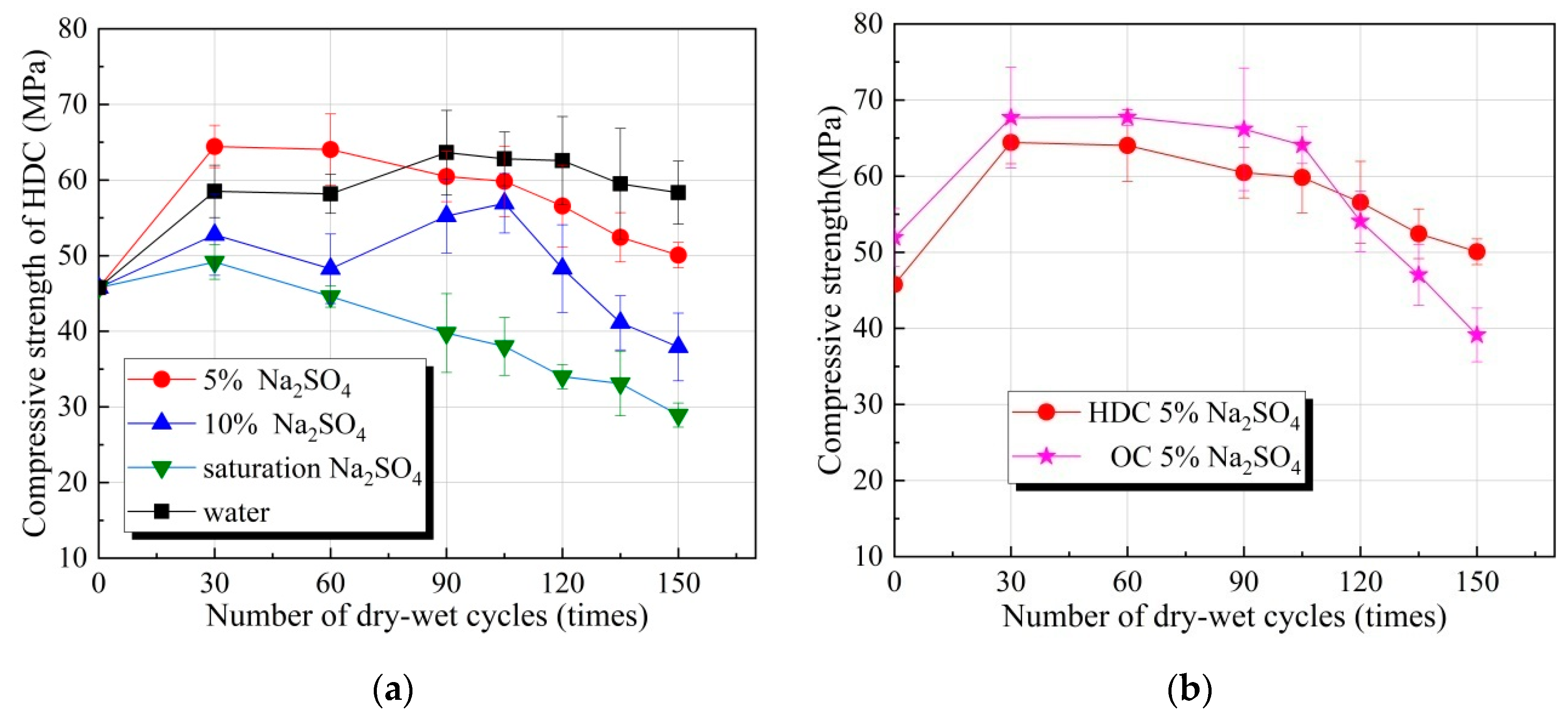


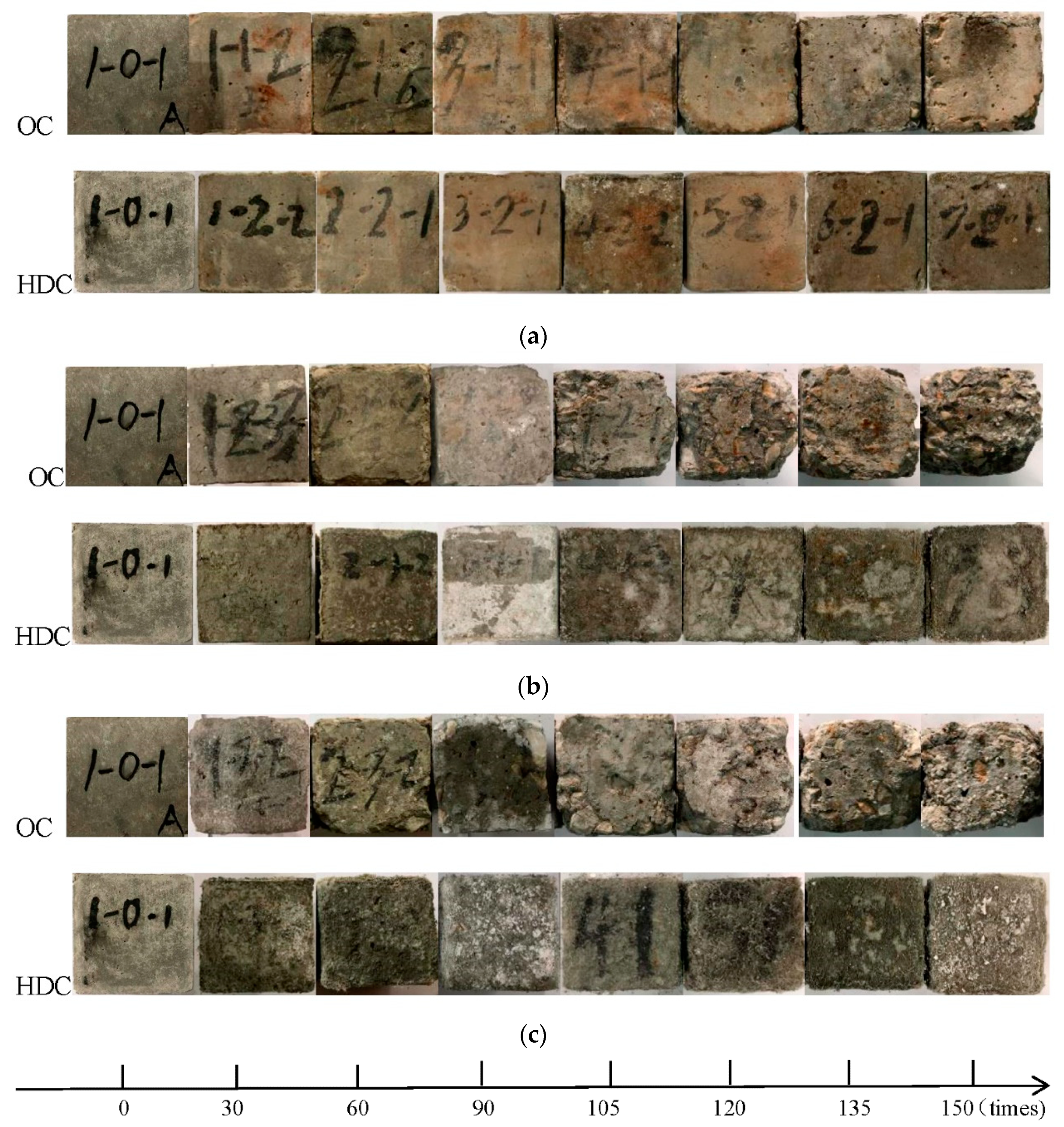
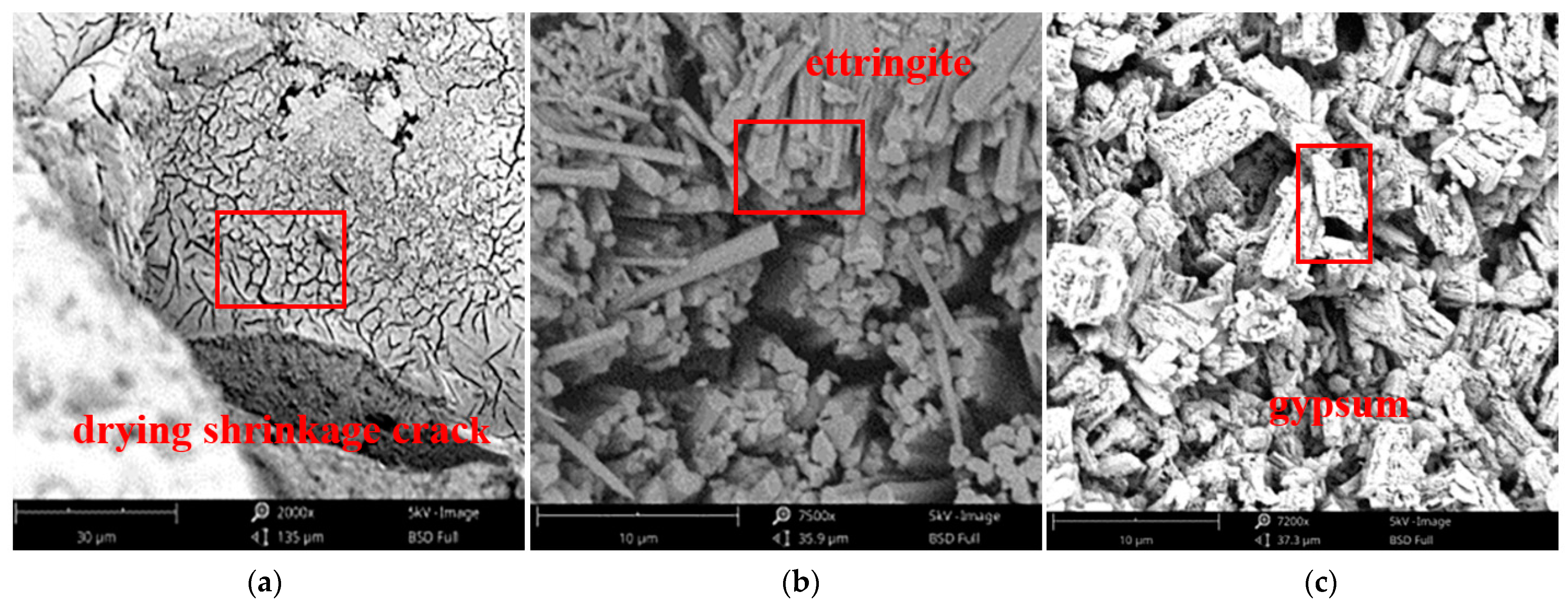
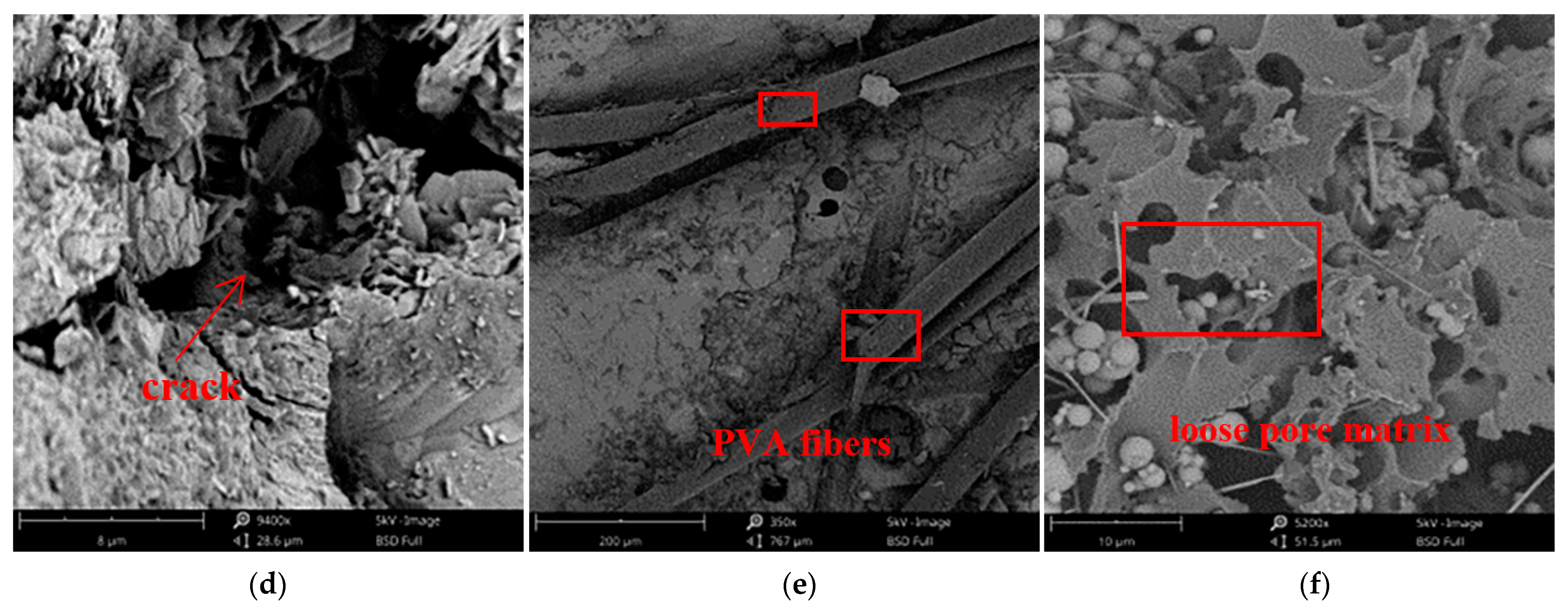
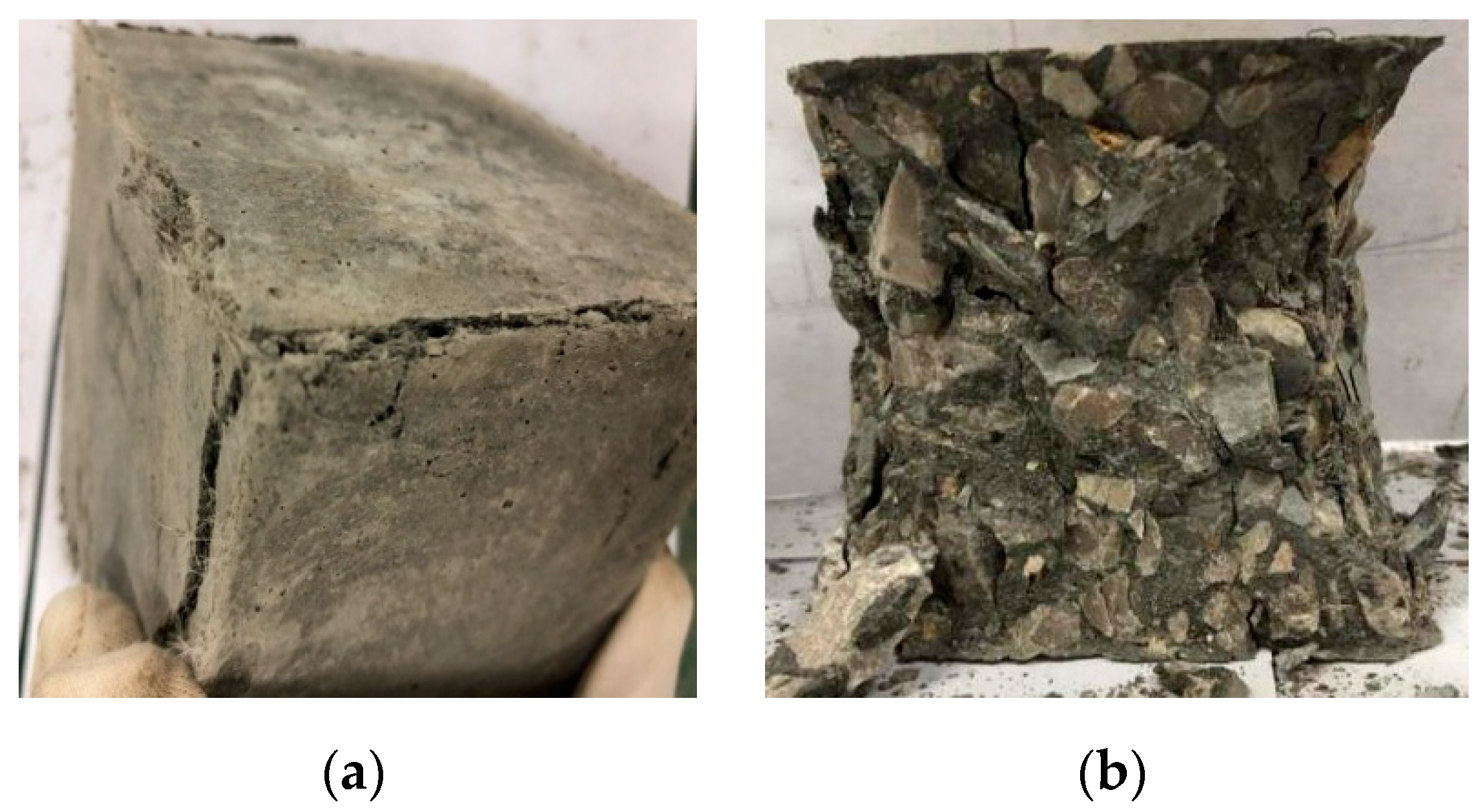
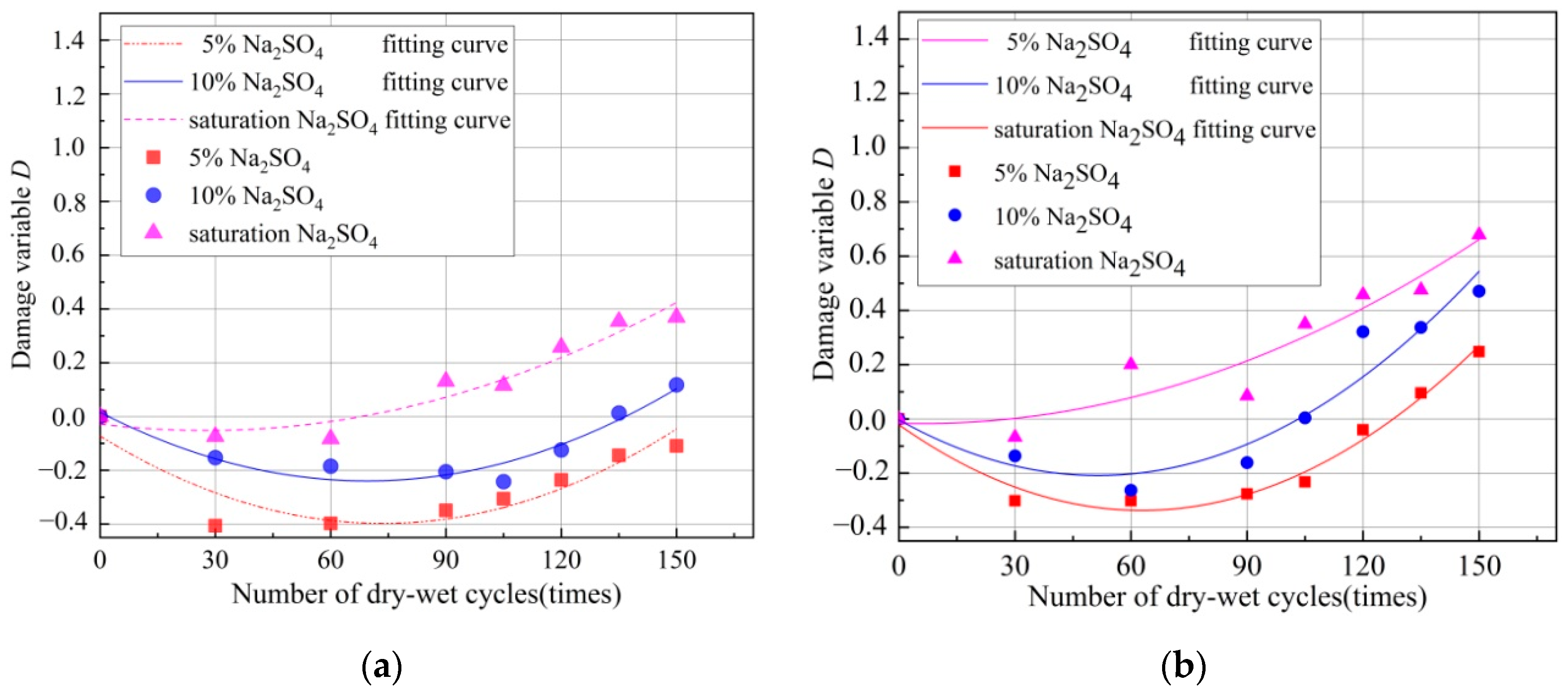
| Length/mm | Diameter/μm | Tensile Strength/MPa | Elastic Modulus/GPa | Elongation/% |
|---|---|---|---|---|
| 12.0 | 39.0 | 1620.0 | 42.8 | 7.0 |
| Specimen Type | Mix Proportion/L | ||||||
|---|---|---|---|---|---|---|---|
| Cement/g | Fly Ash/g | Sand/g | Gravel/g | Water/mL | Water Reducer/mL | PVA/g | |
| HDC | 598.2 | 598.2 | 430.7 | 0.0 | 346.9 | 2.5 | 26.0 |
| OC | 514.0 | 0.0 | 541.0 | 1205.0 | 165.0 | 7.7 | 0.0 |
| Composition | Fly Ash | Cement |
|---|---|---|
| SiO2 (%) | 42.60 | 21.38 |
| Al2O3 (%) | 26.41 | 5.91 |
| CaO (%) | 5.57 | 60.16 |
| Fe2O3 (%) | 4.22 | 2.71 |
| SO3 (%) | 0.28 | 1.96 |
| MgO (%) | 0.83 | 1.25 |
| TiO2 (%) | 1.17 | 0.36 |
| Alkalis (%) | 1.80 | 0.30 |
| P2O5 (%) | 0.20 | 0.44 |
| f-CaO (%) | 0.47 | 0.91 |
| Times | 5% Na2SO4 | 10% Na2SO4 | Saturation Na2SO4 | Water | ||||||||||||
|---|---|---|---|---|---|---|---|---|---|---|---|---|---|---|---|---|
| Compressive Strength/MPa | Mean | Compressive Strength/MPa | Mean | Compressive Strength/MPa | Mean | Compressive Strength/MPa | Mean | |||||||||
| 0 | 46.1 | 45.3 | 45.9 | 45.8 | 46.1 | 45.3 | 45.9 | 45.8 | 46.1 | 45.3 | 45.9 | 45.8 | 46.1 | 45.3 | 45.9 | 45.8 |
| 30 | 66.2 | 65.9 | 61.2 | 64.4 | 52.2 | 58.4 | 47.7 | 52.8 | 51.8 | 47.8 | 47.9 | 49.2 | 59.7 | 61.2 | 54.6 | 58.5 |
| 60 | 62.1 | 60.6 | 69.4 | 64.0 | 52.8 | 48.4 | 43.6 | 48.3 | 45.2 | 43 | 45.6 | 44.6 | 55.2 | 59.5 | 59.8 | 58.2 |
| 90 | 57.8 | 59.4 | 64.2 | 60.5 | 54.8 | 50.6 | 60.3 | 55.2 | 44.8 | 34.4 | 40.1 | 39.8 | 57.2 | 66.6 | 67.1 | 63.6 |
| 105 | 54.7 | 61 | 63.8 | 59.8 | 52.4 | 59.2 | 59.2 | 56.9 | 33.6 | 39.9 | 40.5 | 38.0 | 66.7 | 62 | 59.7 | 62.8 |
| 120 | 61.3 | 57.7 | 50.7 | 56.6 | 41.9 | 49.8 | 53.2 | 48.3 | 32.7 | 33.5 | 35.8 | 34.0 | 67.8 | 56.3 | 63.6 | 62.6 |
| 135 | 48.7 | 53.9 | 54.7 | 52.4 | 43.9 | 42.4 | 37.1 | 41.1 | 37.2 | 33.4 | 28.7 | 33.1 | 66.1 | 60.8 | 51.6 | 59.5 |
| 150 | 49.7 | 51.9 | 48.6 | 50.1 | 42.1 | 33.2 | 38.5 | 37.9 | 27.6 | 30.7 | 28.5 | 28.9 | 62.0 | 59.2 | 53.8 | 58.3 |
| Times | 5% Na2SO4 | 10% Na2SO4 | Saturation Na2SO4 | Water | ||||||||||||
|---|---|---|---|---|---|---|---|---|---|---|---|---|---|---|---|---|
| Compressive Strength/MPa | Mean | Compressive Strength/MPa | Mean | Compressive Strength/MPa | Mean | Compressive Strength/MPa | Mean | |||||||||
| 0 | 48.0 | 52.2 | 55.6 | 51.9 | 48.0 | 52.2 | 55.6 | 51.9 | 48.0 | 52.2 | 55.6 | 51.9 | 48.0 | 52.2 | 55.6 | 51.9 |
| 30 | 74.5 | 67.3 | 61.3 | 67.7 | 53.4 | 59.1 | 52.2 | 54.9 | 50.8 | 54.2 | 61.6 | 55.5 | 67.9 | 73.7 | 72.0 | 71.2 |
| 60 | 66.6 | 67.9 | 68.7 | 67.7 | 71.1 | 68.2 | 65.7 | 68.3 | 43.3 | 49.8 | 52.6 | 48.6 | 68.5 | 66.1 | 72.7 | 69.1 |
| 90 | 74.1 | 66.4 | 58 | 66.2 | 50.1 | 60.4 | 53.8 | 54.8 | 43.5 | 49.7 | 49.7 | 47.6 | 70.1 | 77.1 | 73.9 | 73.7 |
| 105 | 61.5 | 66.3 | 64.4 | 64.1 | 59.4 | 52.5 | 51.8 | 54.6 | 38.5 | 38.8 | 42.9 | 40.1 | 80.7 | 80.1 | 73.5 | 78.1 |
| 120 | 49.7 | 55.1 | 57.4 | 54.1 | 45 | 41.1 | 38.5 | 41.5 | 38.8 | 33.3 | 30.1 | 34.1 | 89.6 | 78.7 | 74.3 | 80.9 |
| 135 | 42.6 | 48.1 | 50.4 | 47.0 | 37 | 33.2 | 33.2 | 34.5 | 30.2 | 26.5 | 25.1 | 27.3 | 77.3 | 77.0 | 67.8 | 74.0 |
| 150 | 35.2 | 40.2 | 42 | 39.1 | 30 | 25.3 | 27.3 | 27.5 | 18.3 | 15.5 | 16.3 | 16.7 | 72.7 | 70.5 | 67.7 | 70.3 |
| Specimen Type | Fitting Parameters | ||||
|---|---|---|---|---|---|
| Na2SO4 | a | b | c | R2 | |
| HDC | 5% | 6.016 × 10−5 | −0.009 | −0.072 | 0.815 |
| 10% | 5.293 × 10−5 | −0.007 | 0.016 | 0.919 | |
| saturation | 3.172 × 10−5 | −0.002 | −0.028 | 0.932 | |
| OC | 5% | 7.995 × 10−5 | −0.010 | −0.022 | 0.975 |
| 10% | 7.746 × 10−5 | −0.008 | −0.004 | 0.917 | |
| saturation | 3.271 × 10−5 | −0.0004 | −0.016 | 0.908 | |
Publisher’s Note: MDPI stays neutral with regard to jurisdictional claims in published maps and institutional affiliations. |
© 2021 by the authors. Licensee MDPI, Basel, Switzerland. This article is an open access article distributed under the terms and conditions of the Creative Commons Attribution (CC BY) license (https://creativecommons.org/licenses/by/4.0/).
Share and Cite
Li, L.; Shi, J.; Kou, J. Experimental Study on Mechanical Properties of High-Ductility Concrete against Combined Sulfate Attack and Dry–Wet Cycles. Materials 2021, 14, 4035. https://doi.org/10.3390/ma14144035
Li L, Shi J, Kou J. Experimental Study on Mechanical Properties of High-Ductility Concrete against Combined Sulfate Attack and Dry–Wet Cycles. Materials. 2021; 14(14):4035. https://doi.org/10.3390/ma14144035
Chicago/Turabian StyleLi, Lingling, Junping Shi, and Jialiang Kou. 2021. "Experimental Study on Mechanical Properties of High-Ductility Concrete against Combined Sulfate Attack and Dry–Wet Cycles" Materials 14, no. 14: 4035. https://doi.org/10.3390/ma14144035






